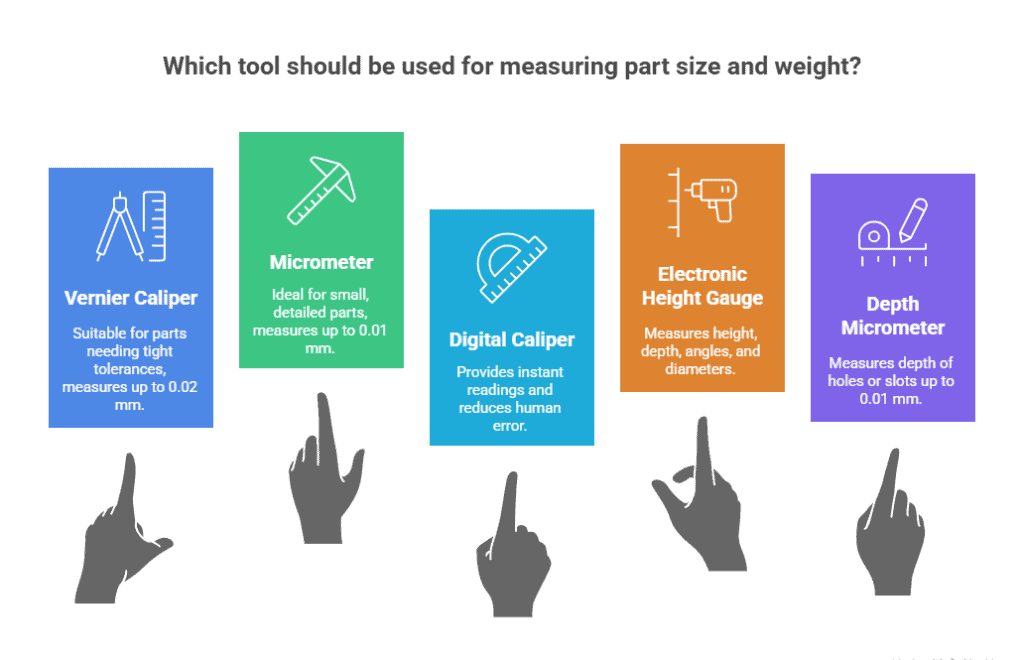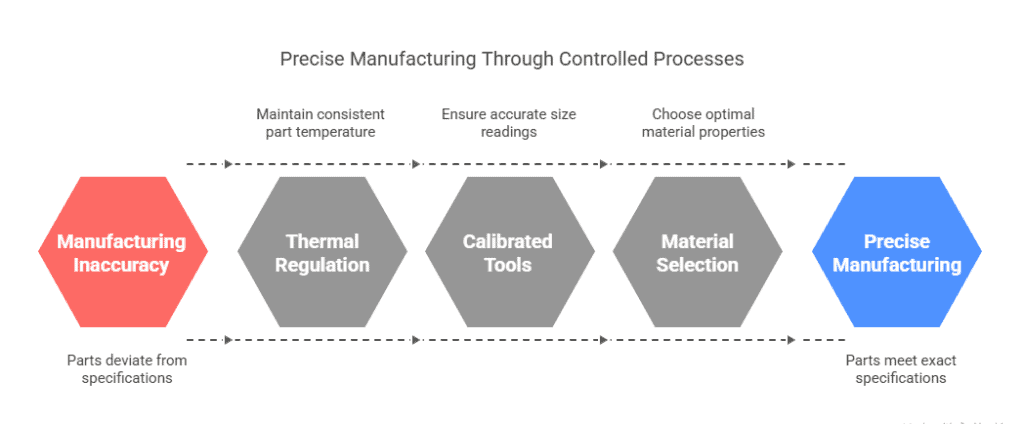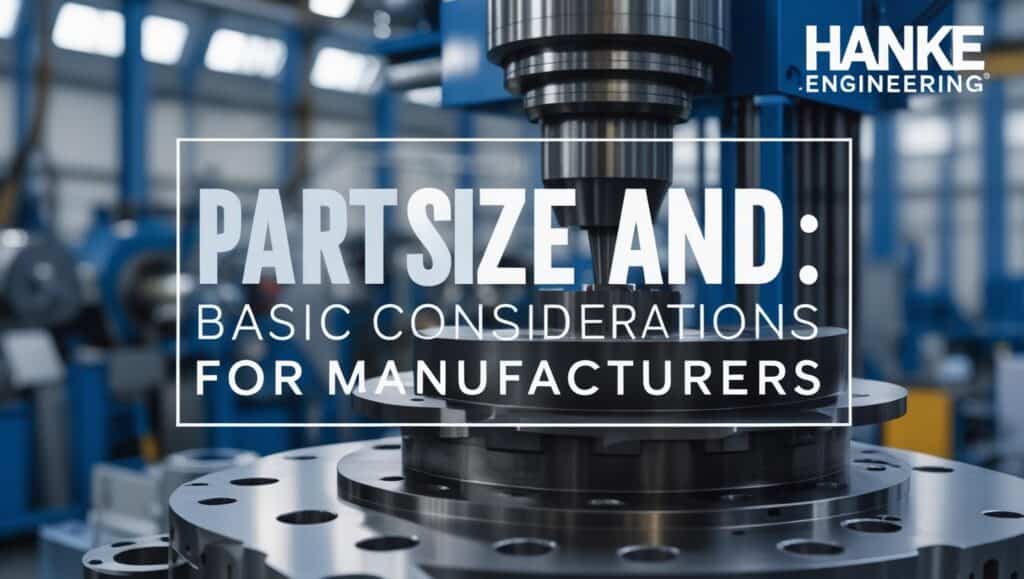In manufacturing, getting the part size and weight is very important. If a part is too big or too heavy, it might not fit, work right, or be safe to use. It can also cost more to make and ship.
In this guide, you’ll learn how to measure and calculate part size and weight. We’ll also show real examples from factories and explain how good planning helps make better, safer products. It all starts with getting the size and weight just right.
Understanding Part Size and Weight
The size and weight of a part matter more than many people think. These two factors affect how the part is made, moved, and used. In manufacturing, even a small change in size can increase the weight and cause delays or extra costs.
The weight of a part depends on two main things: its size and the material used. Bigger parts take up more space, and heavier materials add more mass. For example, a steel part will weigh more than the same-sized part made from aluminum.
To understand this, think about density. The density of a substance is the relationship between the mass of the substance and how much space it takes up (volume). Objects with the same volume but different mass have different densities. If a part has a large volume and is made from a dense material, it will weigh more. That’s why manufacturers must check both the material’s density and the part’s dimensions before production.
For engineers and designers, learning the link between size, density, and volume is key. It helps predict the part’s total weight, which is important for machine limits, transport, and assembly.

Calculating Part Weight from Dimensions
To calculate the weight of a part, you need two things: its volume and the material’s density. It’s a simple formula:
Weight = Volume × Density
Volume is the amount of 3-dimensional space something takes up. Density indicates the mass of a material per unit of volume. When you multiply these two, you get the weight.
You can use online tools or calculators for quick results. Just enter the part’s length, width, and height, then choose the material. The calculator will do the rest.
Each material has a different density. For example, aluminum is lighter than steel, even if the part is the same size. That’s why material choice affects weight so much.
This step is important in mechanical design. It helps engineers make smart decisions about strength, cost, and ease of production.
When part size and weight are calculated early, it helps avoid problems later. Machines can be sized properly, transport loads are known, and safety checks are easier.
Volume Calculation Methods
Geometric concepts like surface area and capacity are important in many career fields. Engineers, graphic designers, animators and other design professionals often measure volume and other metrics to create products and 3D graphics. If your job requires geometry skills, it might be helpful to learn about calculating the volumes of different shapes.
Volume measures the capacity an object can hold. It’s a metric for 3D modeling and applies to many fields, including engineering and drafting, graphic design and product development. Different shapes need different formulas to get this right.
For a box-shaped part, volume is simple: Volume = Length × Width × Height
If the part is a cylinder, the formula changes: Volume = π × Radius² × Height
For a sphere, it’s: Volume = (4/3) × π × Radius³
Each shape has its own method. That’s why it’s important to identify the part’s form first.
Using the wrong formula will give the wrong volume—and that means the part weight will also be wrong. For parts with unusual shapes, software like CAD tools can help calculate volume accurately.
Getting volume right is a key step. Once you know it, you can multiply it by the material’s density to find the part’s weight.
Material Density Considerations
Density is a fundamental property of matter that describes how much mass is contained in a given volume. It is a crucial parameter in various scientific and engineering applications, influencing material selection and behavior under different conditions. Material density is a key factor in calculating part size and weight.
Different materials have different densities. For example, steel is heavier than aluminum. So, even if two parts are the same size, the one made from steel will weigh more.
Here are a few examples:
- Aluminum has a low density. It’s light and easy to move.
- Steel has a higher density. It’s strong but much heavier.
- Magnesium is even lighter than aluminum, making it ideal for weight-sensitive parts.
Choosing the right material depends on the job. A strong, lightweight part may need a low-density material. A heavy-duty part might need something denser for strength.
Understanding density helps engineers strike the right balance between weight, performance, and cost. It also helps when picking machines or designing packaging.

Importance of Accurate Measurements
Accurate measurements are essential when managing part size and weight in manufacturing. If a part is even a little off, it might not fit or work the way it should.
Getting the size and weight right means your product matches the design exactly. This helps you meet safety rules and regulatory standards, which protects your brand and avoids costly recalls.
Customers also notice when things fit perfectly. A product that meets its size and weight limits is less likely to be returned, saving time and money.
Measuring with care allows you to catch problems early. This avoids extra work or wasted materials, which keeps your production line efficient.
When parts are measured properly, they fit together without the need for adjustments. This saves time and improves product quality.
Accurate data also supports innovation. If you’re trying new materials or designs, exact measurements help you test changes safely and effectively.
And let’s not forget worker safety. If tools and machines rely on part weight and size, incorrect data can lead to accidents. Precision protects your team.
Tools and Techniques for Measuring Part Size and Weight
To control part size and weight, manufacturers use special tools that give precise results. These tools help avoid errors and keep quality high.
One of the most common tools is the Vernier Caliper. It can measure outside and inside sizes with accuracy up to 0.02 mm. It’s great for parts that need tight tolerances.
Micrometers are another top choice. External micrometers measure outer sizes with precision as fine as 0.01 mm. They’re perfect for small, detailed parts.
Many shops now use digital calipers. These give instant readings and are easier to use than old-style models. They also reduce human error.
Electronic height gauges are used for taller parts or when more dimensions need to be checked. They can measure height, depth, angles, and even diameters all in one go.
For checking depth, a depth micrometer is ideal. It measures how deep a hole or slot is, down to 0.01 mm accuracy.
For deeper insight into how forging methods impact part size and shape, check out Huasuma’s guide on forging techniques.

How Real Manufacturers Handle Part Size and Weight
Knowing how to measure part size and weight is important in real factories too. One company that works with many kinds of metal parts is called Huasuma. Their factory is in China, and they make strong parts for cars, buildings, and machines.
Their company is located in the Tongshan High-Tech Development Zone of Xuzhou, Jiangsu Province. Founded in 2019, and occupies a land area of 30,000 square meters, with workshop space covering approximately 15,000 square meters.
The company holds multiple national patents, participates in developing industry standards, and exports to over 60 countries worldwide.
Their workers use special tools like CNC machines and laser cutters to make sure every part is the right size and weight. They also use measuring machines to double-check that the parts match the design.
By using the right tools and checking their work, they avoid mistakes. This helps them make parts that fit well, don’t break, and waste less material. Their work shows how important it is to plan and measure carefully.
Impact of Part Size and Weight on Production Processes
Part size and weight affect nearly every step in manufacturing. Bigger parts use more material and cost more to make. Smaller parts can be harder to machine and clean.
Sometimes, two parts look the same but weigh differently. That’s because the material changes the weight. A part made from aluminum will be lighter than one made from steel.
In engineering, designers often try to keep parts strong but light. They do this by choosing materials with the right density and strength.
In CNC machining, large parts may not fit in the machine. If the part is too heavy, it could also affect how accurate the cut is. Small parts, on the other hand, can be hard to clamp and may shift during cutting.
When making deep holes or pockets, tools must be short to stay stable. Longer tools may bend, which leads to poor results.
Complex shapes can also cause problems. If the machine tool can’t reach a certain area, it might leave parts unfinished.
Smart material choices can help. For example, using magnesium instead of steel can make car parts lighter. General Motors used this trick to reduce the Corvette’s engine cradle by 12 pounds.
In aerospace, parts often use lattice structures inside. This makes them light but still strong. These are made using laser-based powder bed fusion, a type of 3D printing.
Even cleaning is affected. Light parts can move too easily in water jets and get damaged. In those cases, a gentle wash works better. Heavy parts need strong support during cleaning.

Case Studies: Real‑World Examples
Managing part size and weight is a major focus for top manufacturers. Here are real-world examples that highlight its impact:
1. General Motors: Magnesium Cradle
General Motors replaced the engine cradle in its Z06 Corvette with a die-cast magnesium version in 2006. This swap reduced weight by about 12 pounds compared to aluminum. General Motors is testing an industry-first thermal-forming process and proprietary corrosion resistance treatment for lightweight magnesium sheet metal that will allow increased use of the high-strength alternative to steel and aluminum.
The use of magnesium, which weighs 33 percent less than aluminum, 60 percent less than titanium, and 75 percent less than steel, will help customers save money at the gas pump, as will more efficient conventional engines and electric powertrains.
2. Atos & Materialise: 70% Weight Cut
Atos and Materialise redesigned a part using additive manufacturing, replacing solid material with lattice structures.
By applying topology optimization and by working with so called lattice structures in the mounting piece, Atos and Materialise were able to reduce the weight per component by nearly 70%. The old component weighs 1454 gram, the new component made with additive manufacturing weighs only 500 gram.
3. 3D‑Printing Engineers: Lightweight Shaft
Using design-for-additive-manufacturing (DfAM), one team cut the weight of a metal shaft by over 50%. They used a honeycomb internal pattern in stainless steel, delivering high strength with much less material.
4. Aerospace Additive via Fuel Nozzles
Airbus and Pratt & Whitney adopted 3D‑printed fuel nozzles in jet engines. These consolidated parts reduced weight by 25%, cut assembly steps, and improved performance .
5. Czinger/Divergent: 3D‑Printed Supercar Chassis
The Divergent Blade is a two-door sports car prototype manufactured by Divergent Technologies, and designed by Kevin Czinger. The Blade is the first automobile to use 3D printing to form the body and chassis. The Divergent Blade (predecessor to the Czinger 21C) used 3D‑printed aluminum chassis nodes, saving up to 90% of weight compared to traditional cars. The chassis alone weighs roughly 46 kg, creating a 630 kg overall vehicle—ultra-light and rigid.

Common Issues and Solutions
In manufacturing, part size and weight can cause real problems if not managed properly. Even a small change in size or material can lead to errors.
One common issue is thermal expansion. When metal heats up during machining, it expands. This makes parts slightly larger than expected. As the part cools down, it shrinks again, which can lead to poor fit or alignment.
To fix this, manufacturers use controlled cooling systems. These systems keep the temperature steady during cutting, which helps avoid changes in size. Some machines even pause briefly to let the part cool between steps.
Another problem is measurement variation. If tools wear out or aren’t set correctly, they may give wrong size readings. Using calibrated tools like digital micrometers and height gauges helps reduce this risk.
Material choice also matters. Soft metals like aluminum can bend or deform during machining. That’s why designers often test several materials before choosing the best one for strength and weight balance.

Need Help with Part Size and Weight? Let’s Talk
Need expert help with your casting design? Contact us for a design review
Our team has years of experience with lightweight designs, material selection, and accurate sizing for manufacturable parts. Whether you’re working with aluminum, steel, or magnesium, we’ll help you get it right the first time.
Need expert support? Request a free design review today and let’s explore how we can make your parts lighter, stronger, and easier to produce.




